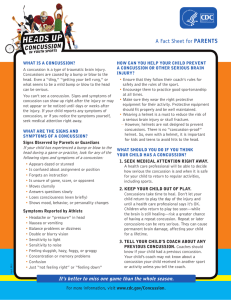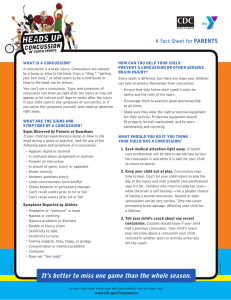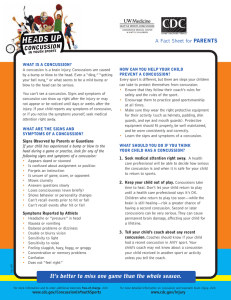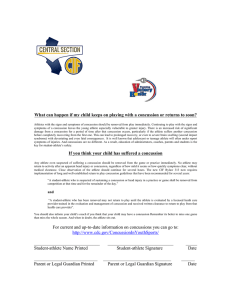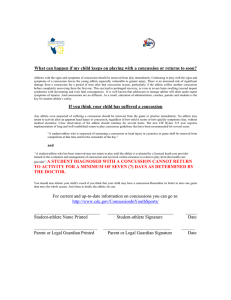Parent/Athlete Concussion Information Sheet - jr
Anuncio
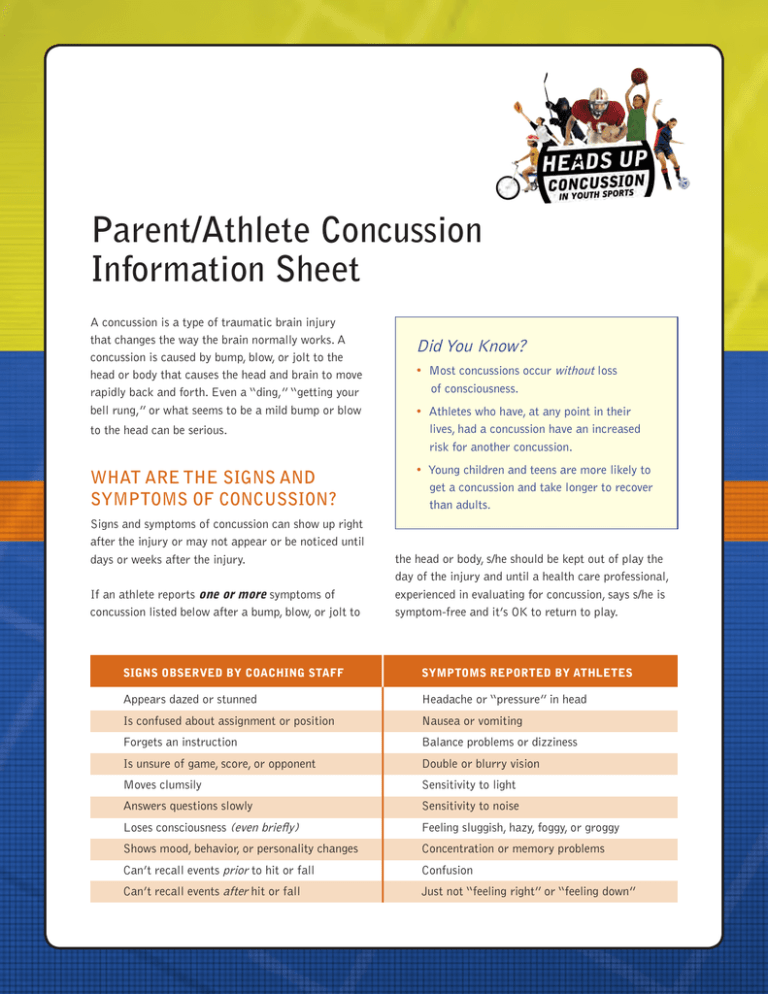
Parent/Athlete Concussion Information Sheet A concussion is a type of traumatic brain injury that changes the way the brain normally works. A concussion is caused by bump, blow, or jolt to the head or body that causes the head and brain to move rapidly back and forth. Even a “ding,” “getting your bell rung,” or what seems to be a mild bump or blow Did You Know? sMost concussions occur without loss of consciousness. to the head can be serious. sAthletes who have, at any point in their lives, had a concussion have an increased risk for another concussion. WHAT ARE THE SIGNS AND SYMPTOMS OF CONCUSSION? sYoung children and teens are more likely to get a concussion and take longer to recover than adults. Signs and symptoms of concussion can show up right after the injury or may not appear or be noticed until days or weeks after the injury. If an athlete reports one or more symptoms of concussion listed below after a bump, blow, or jolt to the head or body, s/he should be kept out of play the day of the injury and until a health care professional, experienced in evaluating for concussion, says s/he is symptom-free and it’s OK to return to play. SIGNS OBSERVED BY COACHING STAFF SYMPTOMS REPORTED BY ATHLETES Appears dazed or stunned Headache or “pressure” in head Is confused about assignment or position Nausea or vomiting Forgets an instruction Balance problems or dizziness Is unsure of game, score, or opponent Double or blurry vision Moves clumsily Sensitivity to light Answers questions slowly Sensitivity to noise Loses consciousness (even briefly) Feeling sluggish, hazy, foggy, or groggy Shows mood, behavior, or personality changes Concentration or memory problems Can’t recall events prior to hit or fall Confusion Can’t recall events after hit or fall Just not “feeling right” or “feeling down” CONCUSSION DANGER SIGNS In rare cases, a dangerous blood clot may form on the brain in a person with a concussion and crowd the brain against the skull. An athlete should receive immediate medical attention if after a bump, blow, or jolt to the head or body s/he exhibits any of the following danger signs: Remember Concussions affect people differently. While most athletes with a concussion recover quickly and fully, some will have symptoms that last for days, or even weeks. A more serious concussion can last for months or longer. sOne pupil larger than the other sIs drowsy or cannot be awakened sA headache that not only does not diminish, but gets worse sWeakness, numbness, or decreased coordination sRepeated vomiting or nausea sSlurred speech sConvulsions or seizures sCannot recognize people or places sBecomes increasingly confused, restless, or agitated sHas unusual behavior sLoses consciousness (even a brief loss of consciousness should be taken seriously) WHY SHOULD AN ATHLETE REPORT THEIR SYMPTOMS? If an athlete has a concussion, his/her brain needs time to heal. While an athlete’s brain is still healing, s/he is much more likely to have another concussion. Repeat concussions can increase the time it takes to recover. In rare cases, repeat concussions in young athletes can result in brain swelling or permanent damage to their brain. They can even be fatal. WHAT SHOULD YOU DO IF YOU THINK YOUR ATHLETE HAS A CONCUSSION? If you suspect that an athlete has a concussion, remove the athlete from play and seek medical attention. Do not try to judge the severity of the injury yourself. Keep the athlete out of play the day of the injury and until a health care professional, experienced in evaluating for concussion, says s/he is symptom-free and it’s OK to return to play. Rest is key to helping an athlete recover from a concussion. Exercising or activities that involve a lot of concentration, such as studying, working on the computer, or playing video games, may cause concussion symptoms to reappear or get worse. After a concussion, returning to sports and school is a gradual process that should be carefully managed and monitored by a health care professional. It’s better to miss one game than the whole season. For more information on concussions, visit: www.cdc.gov/Concussion. Student-Athlete Name Printed Student-Athlete Signature Date Parent or Legal Guardian Printed Parent or Legal Guardian Signature Date SIGNS AND SYMPTOMS These signs and symptoms may indicate that a concussion has occurred. SIGNS OBSERVED BY COACHING STAFF SYMPTOMS REPORTED BY ATHLETE Appears dazed or stunned Headache or “pressure” in head Is confused about assignment or position Nausea or vomiting Forgets sports plays Balance problems or dizziness Is unsure of game, score, or opponent Double or blurry vision Moves clumsily Sensitivity to light Answers questions slowly Sensitivity to noise Loses consciousness (even briefly) Feeling sluggish, hazy, foggy, or groggy Shows behavior or personality changes Concentration or memory problems Can’t recall events prior to hit or fall Confusion Can’t recall events after hit or fall Does not “feel right” ACTION PLAN If you suspect that a player has a concussion, you should take the following steps: 1. Remove athlete from play. 2. Ensure athlete is evaluated by an appropriate health care professional. Do not try to judge the seriousness of the injury yourself. 3. Inform athlete’s parents or guardians about the known or possible concussion and give them the fact sheet on concussion. 4. Allow athlete to return to play only with permission from an appropriate health care professional. July 2007 It’s better to miss one game than the whole season. For more information and to order additional materials free-of-charge, visit: www.cdc.gov/ConcussionInYouthSports U.S. D EPARTMENT OF H EALTH AND H UMAN S ERVICES CENTERS FOR DISEASE CONTROL AND PREVENTION A Fact Sheet for PARENTS WHAT IS A CONCUSSION? April 2013 A concussion is a type of traumatic brain injury. Concussions are caused by a bump or blow to the head. Even a “ding,” “getting your bell rung,” or what seems to be a mild bump or blow to the head can be serious. HOW CAN YOU HELP YOUR CHILD PREVENT A CONCUSSION OR OTHER SERIOUS BRAIN INJURY? t Ensure that they follow their coach’s rules for safety and the rules of the sport. t Encourage them to practice good sportsmanship at all times. You can’t see a concussion. Signs and symptoms of t Make sure they wear the right protective concussion can show up right after the injury or may equipment for their activity. Protective equipment not appear or be noticed until days or weeks after should fit properly and be well maintained. the injury. If your child reports any symptoms of t Wearing a helmet is a must to reduce the risk of concussion, or if you notice the symptoms yourself, a serious brain injury or skull fracture. seek medical attention right away. – However, helmets are not designed to prevent concussions. There is no “concussion-proof” WHAT ARE THE SIGNS AND helmet. So, even with a helmet, it is important SYMPTOMS OF A CONCUSSION? for kids and teens to avoid hits to the head. Signs Observed by Parents or Guardians If your child has experienced a bump or blow to the WHAT SHOULD YOU DO IF YOU THINK head during a game or practice, look for any of the YOUR CHILD HAS A CONCUSSION? following signs and symptoms of a concussion: 1. SEEK MEDICAL ATTENTION RIGHT AWAY. t Appears dazed or stunned A health care professional will be able to decide t Is confused about assignment or position how serious the concussion is and when it is safe t Forgets an instruction for your child to return to regular activities, t Is unsure of game, score, or opponent including sports. t Moves clumsily 2. KEEP YOUR CHILD OUT OF PLAY. t Answers questions slowly Concussions take time to heal. Don’t let your t Loses consciousness (even briefly) child return to play the day of the injury and t Shows mood, behavior, or personality changes until a health care professional says it’s OK. Children who return to play too soon—while Symptoms Reported by Athlete the brain is still healing—risk a greater chance t Headache or “pressure” in head of having a repeat concussion. Repeat or later t Nausea or vomiting concussions can be very serious. They can cause t Balance problems or dizziness permanent brain damage, affecting your child for a lifetime. t Double or blurry vision t Sensitivity to light 3. TELL YOUR CHILD’S COACH ABOUT ANY t Sensitivity to noise PREVIOUS CONCUSSION. Coaches should t Feeling sluggish, hazy, foggy, or groggy know if your child had a previous concussion. t Concentration or memory problems Your child’s coach may not know about a concussion your child received in another sport t Confusion or activity unless you tell the coach. t Just “not feeling right” or “feeling down” It’s better to miss one game than the whole season. For more information, visit www.cdc.gov/Concussion. Hoja Informativa para los PADRES ¿QUÉ ES LA CONMOCIÓN CEREBRAL? Una conmoción cerebral es una lesión en el cerebro, causada por un golpe en la cabeza o una sacudida. Incluso una pequeña conmoción o lo que parece ser un golpe o sacudida leve puede ser serio. La conmoción cerebral no puede verse. Los signos y síntomas de una conmoción pueden aparecer inmediatamente después de la lesión o puede que no aparezcan, o se hagan visibles algunos días o meses después de haber sufrido la lesión. Si su hijo tiene los signos de una conmoción cerebral o si usted nota algún síntoma, busque atención médica de inmediato. ¿CUÁLES SON LOS SIGNOS Y SÍNTOMAS DE LA CONMOCIÓN CEREBRAL? Signos que notan los padres y los tutores Si su hijo ha sufrido un golpe en la cabeza o una sacudida durante un juego o una práctica, obsérvelo para determinar si tiene alguno de los siguientes signos y síntomas de una conmoción cerebral: Abril de 2013 Versión en español aprobada por CDC Multilingual Services – Order # 4421 t Luce aturdido o fuera de control t Se confunde con la actividad asignada t Olvida las jugadas t No se muestra seguro del juego, la puntuación ni de sus adversarios t Se mueve con torpeza t Responde con lentitud t Pierde el conocimiento (así sea momentáneamente) t Muestra cambios de conducta o de personalidad t No puede recordar lo ocurrido antes de un lanzamiento o un caída t No puede recordar lo ocurrido después de un lanzamiento o un caída Síntomas que reporta el atleta t Dolor o “presión” en la cabeza t Náuseas o vómitos t Problemas de equilibrio, mareo t Visión doble o borrosa t Sensibilidad a la luz y al ruido t Se siente débil, confuso, aturdido o grogui t Problemas de concentración o memoria t Confusión t No se “siente bien” ¿CÓMO AYUDAR A SU HIJO A PREVENIR UNA CONMOCIÓN CEREBRAL? Aunque todo deporte es diferente, hay medidas que puede tomar para protegerse. t Haga que siga las reglas impartidas por el entrenador y las reglas del deporte que practica. t Invítelo a mantener el espíritu deportivo en todo momento. t Haga que su hijo use el equipo protector adecuado según la actividad que realiza. El equipo de protección debe ajustarse bien, debe hacérsele el mantenimiento adecuado, y el jugador debe usarlo correctamente y en todo momento. ¿QUÉ DEBE HACER SI CREE QUE SU HIJO HA SUFRIDO UNA CONMOCIÓN CEREBRAL? 1. Busque atención médica de inmediato. Un professional de la salud podrá determinar la seriedad de la conmoción cerebral que ha sufrido el niño y cuándo podrá regresar al juego sin riesgo alguno. 2. No permita que su hijo siga jugando. Las conmociones cerebrales necesitan de un cierto tiempo para curarse. No permita que su hijo regrese al juego hasta que un professional de la salud le haya dicho que puede hacerlo. Los niños que regresan al juego antes de lo debido—mientras el cerebro está en proceso de curación—corren un mayor riesgo de sufrir otra conmoción. Las conmociones cerebrales siguientes pueden ser muy serias. Pueden causar daño cerebral permanente que afectarán al niño de por vida. 3. Informe al entrenador del niño sobre cualquier conmoción cerebral que el niño haya sufrido recientemente. Los entrenadores deben saber si el niño ha sufrido una conmoción recientemente en CUALQUIER deporte. El entrenador no necesariamente sabrá si el niño ha tenido una conmoción en otro deporte o actividad a menos que usted se lo diga. Es preferible perderse un juego que toda la temporada. Para obtener más información, visite www.cdc.gov/ConcussionInYouthSports.
